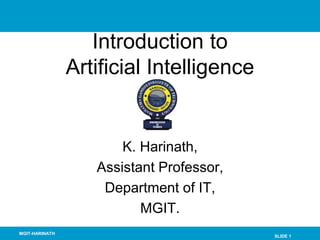
Artificial Intelligence-Introduction
- 1. SLIDE 1 MGIT-HARINATH Introduction to Artificial Intelligence K. Harinath, Assistant Professor, Department of IT, MGIT.
- 2. SLIDE 2 Can Machines Think?? MGIT-HARINATH
- 4. SLIDE 4 What is Intelligence?? MGIT-HARINATH
- 5. SLIDE 5 Involved in Intelligence MGIT-HARINATH
- 7. SLIDE 7 What is AI?? MGIT-HARINATH
- 8. SLIDE 8 Definitions of AI MGIT-HARINATH
- 10. SLIDE 10 HI vs AI (Pros) MGIT-HARINATH
- 11. SLIDE 11 HI vs AI (Cons) MGIT-HARINATH
- 12. SLIDE 12 MGIT-HARINATH “Like People” “Rationally” Think Cognitive Science Laws of Thought Act Turing Test Rational Agents Boundaries of AI ?
- 13. SLIDE 13 MGIT-HARINATH What is AI ? Systems that think like humans Systems that think rationality ``The exciting new effort to make computers think ... machines with minds, in the full and literal sense'' (Haugeland, 1985) ``The automation of activities that we associate with human thinking, activities such as decision-making, problem solving, learning ...'' (Bellman, 1978) ``The study of mental faculties through the use of computational models'' (Charniak and McDermott, 1985) ``The study of the computations that make it possible to perceive, reason, and act'' (Winston, 1992) Systems that act like humans Systems that act like rationality ``The art of creating machines that perform functions that require intelligence when performed by people'' (Kurzweil, 1990) ``The study of how to make computers do things at which, at the moment, people are better'' (Rich and Knight, 1991) ``A field of study that seeks to explain and emulate intelligent behavior in terms of computational processes'' (Schalkoff, 1990) ``The branch of computer science that is concerned with the automation of intelligent behavior'' (Luger and Stubblefield, 1993)
- 14. SLIDE 14 MGIT-HARINATH Acting humanly: The Turing Test approach • The Turing Test, proposed by Alan Turing (Turing, 1950), was designed to provide a satisfactory operational definition of intelligence. • The computer would need to possess the following capabilities: 1. Natural language processing to enable it to communicate successfully in English (or some other human language); 2. Knowledge representation to store information provided before or during the interrogation; 3. Automated reasoning to use the stored information to answer questions and to draw new conclusions; 4. Machine learning to adapt to new circumstances and to detect and extrapolate patterns. • To pass the total Turing Test, the computer will need • Computer Vision • Robotics
- 15. SLIDE 15 MGIT-HARINATH Thinking humanly: The cognitive modeling approach - Program thinks like a human ..! We need to get inside the actual workings of human minds. There are three ways: – through introspection--trying to catch our own thoughts as they go by – or through psychological experiments. – Brain Imaging Cognitive science brings together • Computer Models of AI and • Experimental Techniques from Psychology
- 16. SLIDE 16 CS vs AI MGIT-HARINATH
- 17. SLIDE 17 MGIT-HARINATH Thinking rationality: The Logical approach • Ensure that all actions performed by computer are justifiable (“rational”) • Rational = Conclusions are provable from inputs and prior knowledge • Problems: – Representation of informal knowledge is difficulty – Hard to define “provable” plausible reasoning – Combinatorial explosion: Not enough time or space to prove desired conclusions. Facts and Rules in Formal Logic Theorem Prover
- 18. SLIDE 18 MGIT-HARINATH Acting rationally: The rational agent approach • Rational behavior : doing the right thing ( that which is expected to maximize goal achievement, given the available information). • Rational Agent is one that acts to achieve the best outcomes or, when there is uncertainty, the best expected outcome. Rational agents do the best they can given their resources
- 19. SLIDE 19 MGIT-HARINATH Rational Agents • Adjust amount of reasoning according to available resources and importance of the result • This is one thing that makes AI hard very few resources lots of resources no thought “reflexes” Careful, deliberate reasoning limited, approximate reasoning
- 20. SLIDE 20 AI (Advantages and Disadvantages) MGIT-HARINATH
- 34. SLIDE 34 History of AI MGIT-HARINATH
- 37. SLIDE 37 MGIT-HARINATH Areas of Study in AI • Reasoning, optimization, resource allocation – planning, scheduling, real-time problem solving, intelligent assistants, internet agents • Natural Language Processing – information retrieval, summarization, understanding, generation, translation • Vision – image analysis, recognition, scene understanding • Robotics – grasping/manipulation, locomotion, motion planning, mapping
- 38. SLIDE 38 MGIT-HARINATH Where are we now? • SKICAT: a system for automatically classifying the terabytes of data from space telescopes and identifying interesting objects in the sky. 94% classification accuracy, exceeds human abilities. • Deep Blue: the first computer program to defeat champion Garry Kasparov. • Pegasus: a speech understanding program that is a travel agent (1-877-LCS-TALK). • Jupiter: a weather information system (1-888-573- TALK) • HipNav: a robot hip-replacement surgeon.
- 39. SLIDE 39 MGIT-HARINATH Where are we now? • Navlab: a Ford escort that steered itself from Washington DC to San Diego 98% of the way on its own! • Google news: autonomous AI system that assembles “live” newspaper • DS1: a NASA spacecraft that did an autonomous flyby an asteroid. • Credit card fraud detection and loan approval • Search engines • Proverb: solves NYT puzzles as well as the best humans.
- 40. SLIDE 40 MGIT-HARINATH Surprises in AI research • Tasks difficult for humans have turned out to be “easy” – Chess – Checkers, Othello, Backgammon – Logistics planning – Airline scheduling – Fraud detection – Sorting mail – Proving theorems – Crossword puzzles
- 41. SLIDE 41 MGIT-HARINATH Surprises in AI research • Tasks easy for humans have turned out to be hard. – Speech recognition – Face recognition – Composing music/art – Autonomous navigation – Motor activities (walking) – Language understanding – Common sense reasoning (example: how many legs does a fish have?)
- 42. SLIDE 42 Applications of Artificial Intelligence • Robotic vehicles • Speech recognition • Logistics planning • Robotics • Spam filtering • Game playing • Machine Translation • Medicine • Tele Communications • Banking MGIT-HARINATH